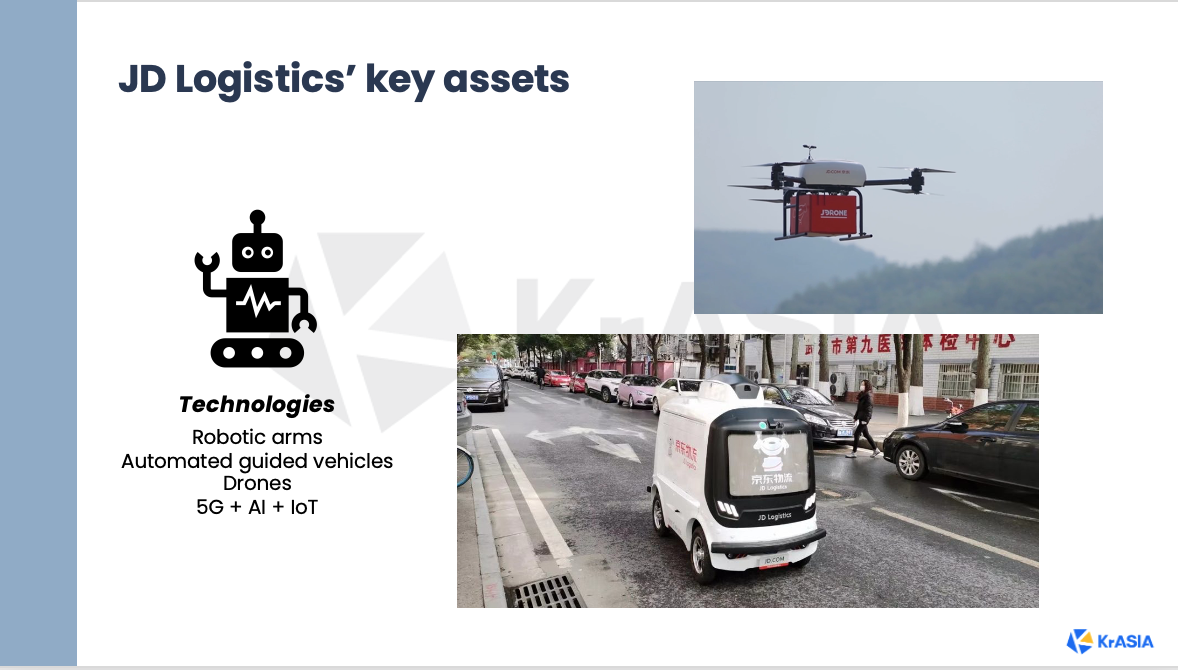The second episode of KrASIA’s Morning Briefing was live on March 16, 9am. This new fortnightly series gives a breakdown on China’s industries, exclusive to our subscribers. The next episode will be on April 6, digging into issues surrounding Electric Vehicle Batteries — click here to save your spot!
Chewing on China’s domestic logistics industry, the presentation had three main parts. A brief overview of the domestics logistics industry in China, the two different business models in the express delivery sector and the case study on JD Logistics.
To start of the the team noted that the value of of the industry has seen a jump from 32.9 trillion USD in 2015 to 45 trillion in 2020. The more than 10 trillion increase illustrates how much the industry has developed and the trend exponential growth hints that the ceiling has yet to be hit.
The scope of the presentation was narrowed down to express delivery services, JD logistics original line of business as the in-house shipping unit for JD.com.

The team examined the main business models seen in the express delivery sector — the independent model and franchising model.
Characterised by heavy assets, the independent model sees companies owning their own proprietary facilities such as warehouses and transport fleets. Their couriers and delivery personnel are also hired as full-time employees. JD Logistics and Shun Feng Express (SF Express) are the two leading companies in this category.
The franchise model, on the other hand, is asset-light. Companies own far fewer facilities, opting for less capital heavy assets such as pick-up lockers. Couriers and delivery personnel are often gig workers. The notable companies in this category are YTO Express, ZTO Express, STO Express and UDA Express, also commonly referred to as 3TO1DA.
During the presentation, the team compared the two models, highlighting three main aspects of differentiation. The first being that the franchise companies have wider geographical coverage in terms of delivery and pick-up locations. SF Express’ approximate 17,900 locations pales in comparison to ZTO’s 30,000.
Second, the independent model brings in higher revenue due to higher prices and more diversified business activity. In contrast, the franchise model occupy larger market share because of their broader physical coverage. Lastly, both models have emerged with differing results when dealing with the pressures of the COVID-19 pandemic. Given that the independent model owns and has more control over its facilities and employees, they were able to enforce proper safety guidelines during the pandemic and continue operations. The franchise players had to bend to external factors such as shut warehouses and workers staying at home.
Moving on to the case study portion of the presentation, the team highlighted that JD Logistics was founded in 2007 as the in-house shipping unit of JD.com. Faced with slowed growth, the larger JD group had to look to new business lines to boost their position. As such, in 2017, JD Logistics was spun off as an independent operation. It was primed to provide a full spectrum of supply chain solutions to all sorts of business clients, instead of just express delivery services.
The team also shared that JD Logistics has three key assets — proprietary facilities and employees, a large warehouse network and advanced technologies. It’s main competitor SF Express too has its own advantages — an air fleet, more pick-up and delivery locations and seems to be the preferred service provider for the likes of third-party clients such as Tabao and TMall.
That being said, JD has a potential competitive edge as it plans to expand its B2B merchant logistics service capabilities. This includes warehouse and inventory management for merchants that lease their warehouses. They have also built an Open Warehouse Platform that allows third-party warehouse owner-operators to use their warehouse management cloud technology in exchange for actual floor space. It was noted that as of the first three quarters of 2020, integrated supply chain customers accounted for 79.1% of the company’s revenue.
Other potential upsides include synergy with fellow subsidiaries under the JD umbrella and continued investment in technology. The team shared that from 2018 to Q3 2020, JD Logistics invested a little over 707 million USD and the end of 2020, it owned and was applying for more than 4,400 technical and software patents. Moreover, the company currently has more than 3,700 R&D personnel.

All in all, there are two main considerations for JD Logistics, it’s IPO and future plans. First, how to continually differentiate itself amongst fierce competitors amongst high cost and continued losses. Second, can further investment in technology support JD the company as it expands into new fields?
